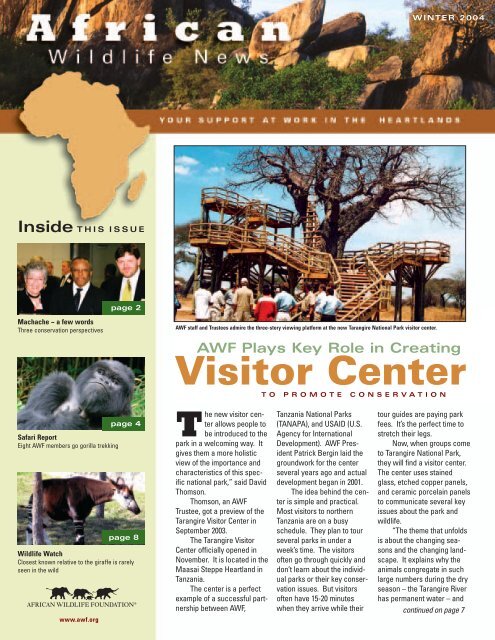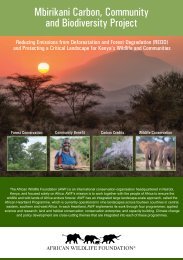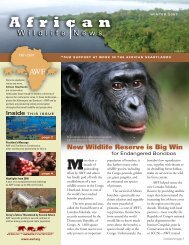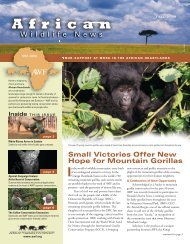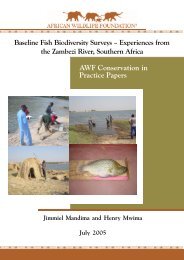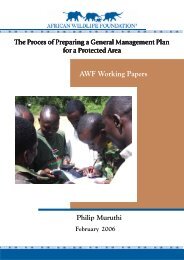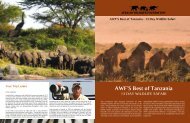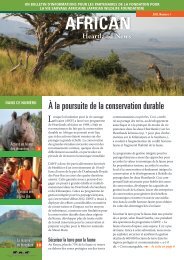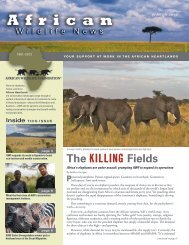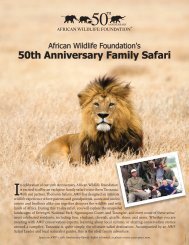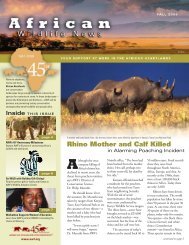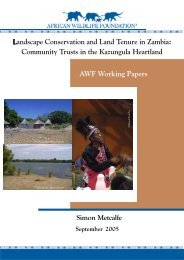New Visitor Center - African Wildlife Foundation
New Visitor Center - African Wildlife Foundation
New Visitor Center - African Wildlife Foundation
- No tags were found...
You also want an ePaper? Increase the reach of your titles
YUMPU automatically turns print PDFs into web optimized ePapers that Google loves.
WINTER 2004Inside THIS ISSUEpage 2Machache ~ a few wordsThree conservation perspectivesAWF staff and Trustees admire the three-story viewing platform at the new Tarangire National Park visitor center.AWF Plays Key Role in Creating<strong>Visitor</strong> <strong>Center</strong>TO PROMOTE CONSERVATIONSafari ReportEight AWF members go gorilla trekkingpage 4page 8<strong>Wildlife</strong> WatchClosest known relative to the giraffe is rarelyseen in the wildwww.awf.orgThe new visitor centerallows people tobe introduced to thepark in a welcoming way. Itgives them a more holisticview of the importance andcharacteristics of this specificnational park,” said DavidThomson.Thomson, an AWFTrustee, got a preview of theTarangire <strong>Visitor</strong> <strong>Center</strong> inSeptember 2003.The Tarangire <strong>Visitor</strong><strong>Center</strong> officially opened inNovember. It is located in theMaasai Steppe Heartland inTanzania.The center is a perfectexample of a successful partnershipbetween AWF,Tanzania National Parks(TANAPA), and USAID (U.S.Agency for InternationalDevelopment). AWF PresidentPatrick Bergin laid thegroundwork for the centerseveral years ago and actualdevelopment began in 2001.The idea behind the centeris simple and practical.Most visitors to northernTanzania are on a busyschedule. They plan to tourseveral parks in under aweek’s time. The visitorsoften go through quickly anddon’t learn about the individualparks or their key conservationissues. But visitorsoften have 15-20 minuteswhen they arrive while theirtour guides are paying parkfees. It’s the perfect time tostretch their legs.Now, when groups cometo Tarangire National Park,they will find a visitor center.The center uses stainedglass, etched copper panels,and ceramic porcelain panelsto communicate several keyissues about the park andwildlife.“The theme that unfoldsis about the changing seasonsand the changing landscape.It explains why theanimals congregate in suchlarge numbers during the dryseason – the Tarangire Riverhas permanent water – andcontinued on page 7
2 <strong>African</strong> <strong>Wildlife</strong> <strong>New</strong>sMachache ~ A FEW WORDSBOARD OF TRUSTEESLeila S. GreenCHAIRMatthew T. WeirVICE CHAIRMANVictoria LeslieSECRETARYDouglas C. WalkerTREASURERPatrick J. Bergin, Ph.D.PRESIDENTJoanna ElliottVICE PRESIDENTHelen W. Gichohi, Ph.D.VICE PRESIDENTTony KalmVICE PRESIDENTThomas W. NicholsVICE PRESIDENT AND ASSISTANT TREASURERFelix O. OtienoASSISTANT SECRETARYEdward M. Armfield, Jr.Robin BerkeleyCrandall C. BowlesWendy McCrary BreckGeorge R. Bunn, Jr.Jacques J. BusquestStephen D. CashinDavid Challinor, Ph.D.Dale F. (Tucker) DornJames L. Foght, Ph.D.Christine F. HemrickWilliam E. (Wilber) JamesDennis J. KellerMark D. KvammeRobin LloydWariara MbuguaHenry P. McIntosh IVAnne B. Mize, Ph.D.Eleanor G. NalleOfer NemirovskyJohn H. NorrisDr. Mamphela A. RamphelePaul A. SchosbergLisa M. StevensDavid ThomsonC. Bowdoin TrainNicholas VingiraiAnnette WilliamsonGordon WilsonTRUSTEES EMERITIArthur W. ArundelE.U. Curtis BohlenJoan DonnerJohn H. HeminwayGeorge C. HixonRichard M. JacksonSally PingreeRussell E. Train<strong>African</strong> <strong>Wildlife</strong> <strong>New</strong>sis published four times a year.COMMUNICATIONS OFFICERElodie Sampéré©2004 <strong>African</strong> <strong>Wildlife</strong> <strong>Foundation</strong>1400 16th Street, N.W., Suite 120Washington, D.C. 20036202-939-3333202-939-3332 (fax)888-4-WILDLIFEE-mail: africanwildlife@awf.orgWeb site: www.awf.orgPrinted with soy-based inkRecycled PaperWhich perspective do you have whenit comes to conservation?Ihave worked in <strong>African</strong>conservation for thepast 15 years. Duringthis time, I have noticed threedistinct perspectives held byconservationists concerningAfrica that I want to sharewith you.The first group is thepeople who say, “if only wecould turn back the hands oftime.” These people are fullof stories about the largenumbers of wildlife that usedto exist. They express wistfulhope that we could somehowgo back to that time.The second groupbelieves “we have our fingerin the dike and we’re holdingback the flood.” This group'sperspective is that Africa'swildlife and wild lands aredoomed. They think those ofus working in conservationcan only hope toslow down theinevitable. They telltheir friends to rushto Africa with theirkids and see thewildlife because itwon’t exist in anothergeneration.The third group asks,“what can we do today tomake sure Africa’s wildlifeand wild lands are heretomorrow – and endureforever?”For this group, <strong>African</strong>conservation is about findinga balance in which wildlifecan thrive and people canalso benefit. It is about doingwhat we can to create anAfrica that is much moreprosperous than the Africaof today. This group takesaction because any otheralternative for Africa’s wildlifeThe Honorable Festus Gontebanye Mogae, President of Botswana, withAWF’s Board of Trustees Chair, Leila Green, and Patrick Bergin.and people is not acceptable.As I’m sure you know,AWF is part of the third group.Since you are an AWF member,you must also be part ofthis group. And I’m so thankfulyou are.At our “Conservation isGood Business” symposiumThis group takes actionbecause any other alternativefor Africa’s wildlife andpeople is not acceptable.in November, we gatheredmany people from across theU.S. and Africa who are alsoin this third group.Our distinguished guestsincluded Festus Mogae,President of Botswana; PiusMsekwa, Tanzania’s Speakerof the National Assembly; U.S.Senator Lamar Alexander, theChairman of the Subcommitteeon <strong>African</strong> Affairs; andAndrew Natsios, Administratorof USAID.This symposium was partof AWF’s bigger plan to helpall of us focus our attentionon the opportunities that stillexist in Africa: opportunitiesto set aside large, viable landareas for conservation andinvestment in ways that willmake both ecosystems andnations richer.The countries ofBotswana and Tanzania areperfect examples – they arereaping significant economicbenefits from investingin conservationof large areas. Andthere is still potentialfor more growth thatwill benefit the wildlifeand the people.I am thankful that bothcountries were representedat our symposium. The experienceand wisdom they providedwas invaluable to allwho were able to attend. AndI want to thank you, our members.Without you, our workto protect the wildlife andconserve the wild lands ofAfrica would not be possible.Together, we are making adifference for Africa today,tomorrow, and forever.Patrick J. Bergin, Ph.D.AWF President & CEO
Africa’s <strong>Wildlife</strong>Inspires a Lifetimeof GivingFor over 30 yearsDavid Delacourhas held a powerfulimage in his mind:Africa’s big cats – cheetahs,lions, and leopards –roaming in the wild withlarge herds of gazelles andantelope.“I have always beenfascinated by Africa. Iwas fortunate enough togo there in 1972, and atthat time I became committedto preserving thewildlife,” David says.“Supporting AWF is myway of doing this.”David’s passion forconservation carries overinto his estate plans. Hisdesire is to leave a legacyso future generations canenjoy the wildlife and wildlands of Africa.First, he established acharitable remainder trust.This provides David withlife-long income whileallowing him to avoid capitalgains taxes he wouldhave incurred by sellingstocks. He also increasedhis income over what hederived from stocks andbonds. And, at the sametime, the trust strengthensAWF’s critical conservationprograms.Second, David establisheda living trust. Thismakes it possible for Davidto benefit heirs and charitablebeneficiaries withoutinvolving a probate court,saving both time andmoney. David can reclaimthe assets of the trust ifneeded for healthcare orother personal needs. Theliving trust also provides ameans for careful managementof David’s financialand personal affairs inthe event of disability.The proceeds ofDavid’s gifts to AWF willprovide an enduringlegacy that reflects hisdevotion to Africa.If you want to leavea legacy for future generations,go to ww.awf.org/act.Or call 202-939-3333 or888-4-WILDLIFE and give usyour state of residence.We will connect you withyour regional planned givingofficer.David Delacour is leaving a legacy to protect lions and other<strong>African</strong> wildlife and conserve their habitat.Bill Passes to Promote CongoBasin ConservationThe U.S. Senateunanimouslypassed the CongoBasin Forest Partnership(CBFP) Act, HR 2264, onDecember 9, 2003. The billformally authorizes U.S.participation in the CBFP,which aims to protect 11key landscapes encompassingmore than 30national parks and thousandsof square milesacross six countries incentral Africa.Senator LamarAlexander of Tennesseeled the effort. He said,“The Congo Basin ...extends over 700,000square miles into six<strong>African</strong> countries andcontains the most diversegrouping of plants andDavid DelacourJames Weisanimals in Africa.”AWF is a memberpartnerof CBFP and willtake the lead in carryingout conservation programsin theMaringa/Lopori-Wambalandscape. This landscape,located inDemocratic Republic ofCongo, is AWF’s newestHeartland.<strong>African</strong> <strong>Wildlife</strong> <strong>New</strong>s 3<strong>New</strong>s in BriefAWF Staff Run toRaise Funds forHIV/AIDSAWF staff women, including VicePresident for Program Dr. Helen Gichohi,took part in the “Women’s HIV/AIDS Run”last September. The run is the first of itskind in Kenya and represents a bold, positivemove in the fight against HIV/AIDS.The event served to create awareness andraise funds for HIV/AIDS programs inKenya. More than 10,000 women participatedin the run. The event kicked off the13th International Conference on AIDS andSexually-transmitted Infections in Africa.U.S. DentistsConduct Clinic inManyara RanchDr. Brian Swann and Manyara Ranch Primary Schoolstudents wave their new toothbrushes.A team of dentists from the U.S. visitedManyara Ranch in AWF’s Maasai SteppeHeartland at the end of October. Thedentists donated their time to host a dentalclinic for the Manyara Ranch PrimarySchool. They also donated a significantamount of healthcare equipment, includingtwo microscopes, stethoscopes, andmedication.They conducted dental screeningson students and also held dental hygienetraining. Many of the staff and studentshave poor dental health because of thehigh saline content in the water, so thisvisit was very timely.The <strong>African</strong> <strong>Wildlife</strong> <strong>Foundation</strong>organized the ranch visit in collaborationwith the National Dental Association. Thetrip was led by Dr. Brian Swann of DentalSolutions in San Jose, California.
4 <strong>African</strong> <strong>Wildlife</strong> <strong>New</strong>sSafari Report FROM CRAIG SHOLLEYAWF Members ShareExperience of a LifetimeWhile Gorilla TrekkingJulia Wasserman has been amember of AWF for more than20 years. She serves as aState Representative in theConnecticut legislature.Julia took part in AWF’s safarito Rwanda and Uganda this pastOct-ober. Thirty-five years ago,Julia and her husband visitedUganda and had fond memoriesof their time there.So, when Julia read anarticle in Nature’s BestMagazine about the safari,she decided to go. Shesaid, “I’ve always wantedto see the gorillas.”Julia highly recommendstaking a safaribecause it allows AWFmembers to see exactlyhow their support ismaking a difference forthe wildlife and theirhabitat.Her top three highlightswere “the incrediblebeauty of the countries,the gorillas, andthe guides – they werefantastic, extremelyfriendly.”Eight AWF members are joined by their safari guides.Safari — Through theEyes of One MemberCraig R. SholleyJulia was so inspired by hersafari experience that she hasbecome a Founding Member of ourMountain Gorilla Conservation Trust.This major donor giving programfunds the International GorillaConser-vation Program (IGCP) andAWF’s work to support it – protectingone of the world’s rarest apesand the land they call home.Craig R. SholleyEvery time I return to Uganda and Rwanda, itfeels like a homecoming. And on AWF’s recentOctober safari to these beautiful countries, Iwas able to share the emotion of homecoming witheight AWF members.The focus of our safari was gorillas, but we alsovisited wildlife areas in vivid contrast to Bwindi’s ImpenetrableForest and the Virunga Mountains. Theseincluded Kibale and Queen Elizabeth National Parks(QENP).In Kibale, the forests provide primate wondersfound few other places in the world. Observations inKibale included a mixed troop of 50 red colobus and redtailedmonkeys feeding peacefully on fruit high abovethe forest floor. Elsewhere, small groups of black andwhite colobus were seen regularly, as were large troopsof olive baboon and the occasional grey-cheekedmangabey.The highlight of Kibale was Uganda’s other greatape – the common chimpanzee. In a giant fig treestretching 150 feet upwards, we discovered 20 or morechimpanzees feeding frantically on figs. They expressedtheir delight intermittently with pant-hoots, whichresounded throughout the forest.It is nearly impossible to describe how loud excitedchimpanzees can be – suffice it to say the AWF group ofHomo sapien cousins craning necks below erupted inlaughter and smiles each time a new chimp discoursetook place.Continuing to QENP, the terrain changed dramatically.Ancient volcanic craters dot the landscape of oneof the continent’s most beautiful grassland ecosystems.QENP is home to the largest concentrations of Nilehippo, and a launch trip on the Channel placed ourgroup in the midst of large hippo schools.Elephants, buffalo, waterbuck, warthog, andUganda kob drank or wallowed at the water’s edge. Abounty of birdlife, ranging from the diminutive malachitekingfisher to the striking saddle-billed stork and greatwhite pelican, adorned the shoreline.Elsewhere in the park, we spent the morning withtwo lionesses and five six-month-old cubs as theylounged lazily, recovering from gorging themselves onan old male kob taken the evening before.Gorilla trekking is always intimidating, and I smileas a group’s excitement grows the evening before theircontinued on page 5
8 <strong>African</strong> <strong>Wildlife</strong> <strong>New</strong>s<strong>Wildlife</strong> WATCHOkapiCardo KlebergThe okapi is the closest known relativeof the giraffe. It is muchsmaller – weighing 450-550pounds compared to up to 3,000 for thegiraffe. The okapi stands 5-1/2 to 6 feet tall.The giraffe is about 18 feet tall.Their similarities include a very long,muscular tongue that can wrap aroundbranches and strip the leaves and budsinto its mouth. The okapi can even cleanits eyes with its tongue. The bodies of bothanimals also slope, with the front legs positionedhigher than the back.The okapi’s most striking feature is thenarrow white stripes on its legs and rumpthat contrast with its dark brown body.Rarely seen in the wild, the okapi isone of the last large mammals identified bythe scientific community in the 1900s. Thename is adapted from o’api, which is whatthe Bambuti pygmies call these animals.Okapi are active during the day. Theymake their way through the jungle on welltroddenpaths, eating leaves, grasses, andThe okapi is found only in the dense rainforestsof northern Democratic Republic of Congo.fruit. Young animals make a wide variety ofnoises, including coughs, bleats, and whistles.But the older okapi are silent most ofthe time.It is estimated that there may be30,000 okapi in the wild, but there hasnever been an official count. The biggestthreat to their survival is the increase ofhuman settlements in their range.Recently, political clashes havedamaged the Okapi <strong>Wildlife</strong> Reserve inDemocratic Republic of the Congo wherean estimated 5,000 okapi live. Rangershave been forced to flee into the forest,increasing the risk of poaching.As an AWF member, you help protectunique wildlife like the okapi throughyour support.For more profiles of the animals youhelp protect through your support of the<strong>African</strong> <strong>Wildlife</strong> <strong>Foundation</strong>, please visitwww.awf.org/wildlives/guidebook.php.Festival FeaturesFilms About AfricaThe 2004 Environmental FilmFestival in the Nation’s Capital willpresent over 100 documentary, animated,feature, archival, and children’sfilms. These films are selected toprovide fresh perspectives on environmentalissues affecting our planet. Thefestival is March 18-28. Some of thefilms relating to Africa are: Cheetah:Cats in Crisis, Wild Africa, The CulturedApe, and Snake Hunters of the Kalahari.For a complete film schedule, go towww.dcenvironmentalfilmfest.org orcall 202-342-2564 for a film brochure.★★★★AWF ReceivesTop RankingFor the second year in a row, AWFhas earned a top, Four-Star overall ratingfrom Charity Navigator. AWF alsoreceived Four-Star rankings for our organizationalefficiency and organizationalcapacity. This ranking is based on howwell a charity sustains its efforts over time.Charity Navigator is a non-profitorganization that helps donors makeintelligent giving decisions by providinginformation, including a financial healthevaluation, on over 2,600 charities.Yes, I Want to Protect the <strong>Wildlife</strong> and Conserve the Wild Lands of AfricaPLEASEGIVETODAYI will partner with AWF to save the wildlife and wild lands ofAfrica by conserving the <strong>African</strong> Heartlands. I’m enclosing:■ $25 ■ $50 ■ $75 ■ $100 ■ $500 ■ $_____________________________________________________________________________________________NAME______________________________________________________________________________________ADDRESS_______________________________________________________________________________________CITY STATE ZIP_______________/________________________ ____________________________________________PHONEE-MAIL ADDRESSThank you! Please detachthis form and return it withyour tax-deductible check inthe enclosed envelope to:<strong>African</strong> <strong>Wildlife</strong> <strong>Foundation</strong>,1400 Sixteenth Street, N.W.,Suite 120, Washington, D.C.20036.If you have any questions,call us at 1-888-4-WILDLIFE.James Weis■ Please send me information aboutlegacy gifts to save Africa’s wildlife.■ Please send me your online newsletter, AWFAfrica <strong>New</strong>s, so I can receive special updateson breaking news affecting the wildlife andwild lands of Africa.Please visit our Web site atwww.awf.org.A043


